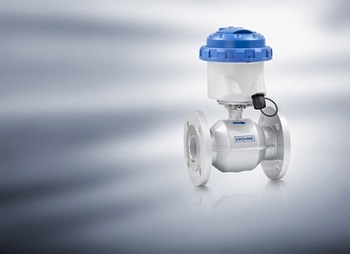Jun 14 2016
KROHNE introduces several new features and options for WATERFLUX 3070. As water meters are often installed in remote locations, reducing the frequency of visits to the sites and the time spend on set-up and maintenance is crucial.
 WATERFLUX 3070 C battery powered water meter with new features and options
WATERFLUX 3070 C battery powered water meter with new features and options
This relies on aspects such as a simplified installation, integrated diagnostics, a long battery lifetime, remote communication options and low overall maintenance requirements of the meters. All new features and options for the WATERFLUX contribute to these targets.
- Effecting simple installation and reduced maintenance
- Mains power option with battery backup
- First all-in-one water meter with integrated pressure and temperature sensor
- Modbus RTU communication option for transmission of readings, meter status and alarms
- Certification to OIML R49 and MID MI-001 with 0 DN/0 DN up to DN600/ 24"
In terms of installation, the polycarbonate converter housing with protection class IP68 rating is now standard for both compact and remote version, e.g. for temporarily flooded measuring pits. It features IP68 waterproof plug and play connectors that do not require wiring on site, and a small installation footprint to fit into electrical cabinets.
For locations where mains power is available, WATERFLUX 3070 is now available with an external FlexPower unit to connect the meter to a 110…230V AC or 10…30V DC power source on site, e.g. an electrical grid, a solar panel or a small windmill. The FlexPower module also has an internal battery that serves as a battery backup in case the external power source fails.
The integrated pressure and temperature sensor is a new option to allow the use of WATERFLUX for various tasks in drinking water networks: Flow and pressure measurement data are an important input for pressure monitoring, maintaining the water balance, district zoning (DMA), and for leak detection in drinking water networks when comparison of pressure and flow values is used as method. With WATERFLUX, KROHNE now offers the first all-in-one water meter for this application, eliminating the installation and wiring of separate flow, pressure and temperature sensors. Pressure and temperature values are available via the display or via Modbus, e.g. temperature data can be used for quality monitoring of potable water. Alarms can be generated via the status output or via Modbus when critical limits for pressure and or temperature are exceeded. The integrated pressure and temperature sensor is available for diameters DN50…200 / 2…4".
The communication options have also been extended to meet water companies increasing demand for more measurement and status data from water meters. The new Modbus RTU output offers an alternative to the two pulse and two status outputs, transferred data includes measurement data (sum, forward and reverse counters, flow rate), status data (battery lifetime, meter status), actual values for pressure and temperature, and alarms. Modbus RTU can be provided via a low (battery) power and a high (mains) power version. The low power Modbus version is unique to the market and can be used for data communication between a stand-alone battery powered WATERFLUX 3070 version and a data logger GPRS module. When mains power operated with FlexPower, the high featured Modbus option can be used for data transfer to automation and process control systems.
For the sensor, thread connections G1” for DN25 and G1,5” for DN40 are now a regular option for small nominal diameters, When ordered with flanges, nominal diameters DN25…200 / 1…8" are equipped with stainless steel flanges as standard. Previously only available for smaller diameters, WATERFLUX with large nominal diameters up to DN600/ 24" can now also be verified to OIML R49 and MID MI-001 with 0 DN / 0 DN straight inlet / outlet.
Introduced in 2009, the WATERFLUX battery powered water meter remains a very successful product in the drinking / clean water market, and is continuously updated to keep up with modern requirements. Certified to MID MI001 and OIML R49, it features a unique rectangular measuring tube design. Because inlet or outlet sections are not required, the sensor allows for a compact installation and a small overall installation footprint. There is no need for grounding rings because as standard the flow sensor has a reference electrode for grounding. A special coating allows for subsoil installation of the sensor.